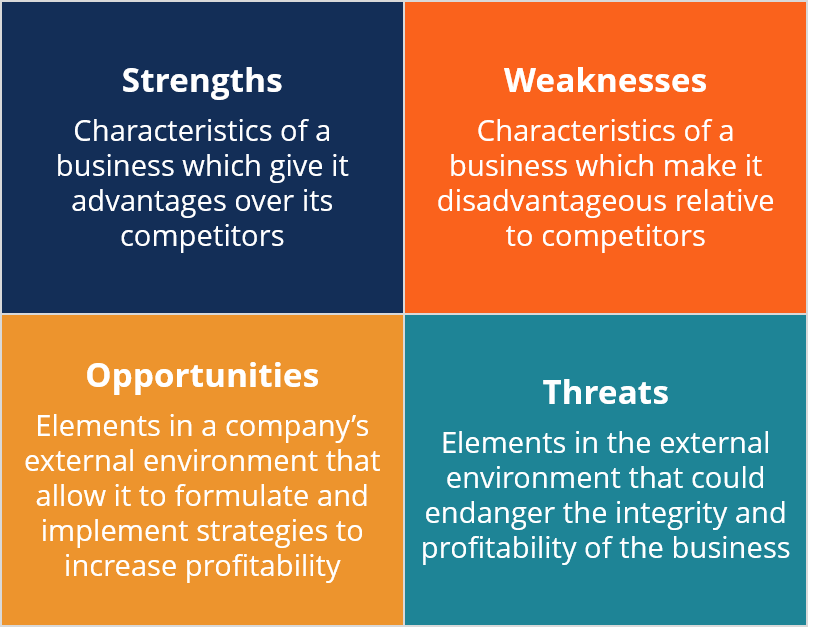How to Use SWOT Analysis for Your Event
When you are making efforts to create growth within your business, you should use every effective strategy available to you to ensure you get a clear picture of where you stand and how you can improve.
In fact, individuals and companies working within the event planning industry should be using the helpful strategy analysis called SWOT to gain a better understanding of their approach and opportunities for an individual event and/or brand.
Using this method can allow you to make the most out of each event and consistently see satisfactory results for each endeavor.
Remember, “Opportunities don’t happen. You create them.” - Chris Grosser
What is a SWOT analysis?
SWOT analysis is one of the top, traditional methods for outlining a situation or an event to determine what issues you face and discover how to effectively overcome them.
So, what exactly is a SWOT analysis?
The acronym SWOT, stands for:
• S-strength
• W-weakness
• O-opportunity
• T-threat
SWOT analysis is used to identify both internal and external factors influencing a situation or business plan. The idea is to create a graph/layout of each point in relation to your company and the event itself.
Keep in mind these questions when you are building your SWOT analysis with your team. The more in depth of a swot analysis for event management you have, the stronger event and branding strategy you will build.

Strengths
These are the positive contributions of your company and/or upcoming event.
Everything you can control and create positively are your strengths. Since this article is about using SWOT for planning your event, all the questions below will be in regard to event attributes. Consider the following when building your strengths.
- What are the highlights of your event?
- What processes in planning are successful?
- What activities at the event are or have been successful?
- What assets do you have in your team? Strong skills? Leadership? Knowledge?
- What is the reputation of your event? Is strong?
- What advantages do you have over your competition?
- What makes you event different/unique from the rest?
Weaknesses
A weakness is what sets you apart from the rest negatively; they take away from your strengths. To focus on your weaknesses, assess and answer the following questions and see what areas need improvement.
- What asset of your event is holding you back from further success? Location? Market?
- What is your business lacking? Money? Resources?
- Do you have a complete team? Any positions that are missing?
- In what areas can you be more competitive in?
- Anything that noticeably needs improvement in your event?
Opportunities
Opportunities are options out there that can contribute to your growth.
Use this part of your chart to find what you can seek out to improve and build stronger for your event and/or company.
- What are the market trends?
- What is your customers’ buyer's journey? Are you nurturing all your leads during this process?
- How can you encourage more ticket sales?
- Is your buying process accommodating and accessible?
- How can you improve your event reputation? Reviews? Testimonies? Videos?
- Are you marketing your event in every way possible?
- Is your admissions/ticketing software flexible?
- Are you staying updated with all the latest event trends?
Threats
A threat. Something you have absolutely no control over, unfortunately.
By having an external factor that could impact your event/company negatively, it’s important to consider creating a strategy for dealing with these threats if they ever occur.
Consider the following questions when building out this plan.
- Who is your competition?
- Who could potentially be your competition or come into the market?
- How is the technology you use evolving?
- Is your event/business still with the current trends of the market?
- Are consumer patterns changing?
What are the company’s strengths in relation to the proposed event?
For example, a sporting event, does your company have a connection within the sports industry you can harness? If you are hosting a gala, do you have the ability to hire popular or renowned talent for the event through connections?
Likewise, when it comes to weakness, where are you lacking in relation to the event at hand?
Is your budget limiting you to other possibilities, and if so, how can you increase or gain extra funds?
For the opportunity section, you would highlight any unique opportunities around you that can help propel the event to even greater success.
Finally, you want to outline any potential threats you face that stand in the way of creating and hosting a successful event or endeavor.

This infographic was created by Venngage Graph Maker
Why should you use SWOT analysis?
An event SWOT analysis allows you to clearly state and highlight the most important features of your strategy, positive and negative.
Taking the time to highlight your strengths and the different opportunities can allow you to focus in on them or address them more directly, and in contrast, outlining the weaknesses and threats can give you the chance to make strategy corrections and be aware of things that can sabotage your efforts.
Planning a strategy or event can include multiple interactions and points of interest that tend to blend together, making the big picture a little cloudy.
This is a direct and simplified way to point out the most critical details and keep them in the forefront of the plan to help direct your efforts to increase productivity and positive results.
Taking the time to create a detailed swot analysis for event management saves you time in the long run.
Limit surprises from unexpected issues
Another way the SWOT analysis can be incredibly beneficial is by translating as your outline for potential issues that can pop up, ultimately showing you how to recover from a hard blow with ease.
An example would be the weather for an outside event.
What if it rains, or the temperatures are not favorable?
That is considered an external factor that could threaten your event.
Then, you would be able to identify this threat and create a backup plan by knowing where and how to secure an indoor facility or plan if necessary.
Other issues may be key speaker who are unable to make it or run into delays in transit. A solution could include a live feed scenario as a backup plan or scheduling an alternate speaker for a hybrid presentation.
Clearly outline where you shine
We sometimes forget exactly where are strengths and opportunities lie. Taking some time to focus on them and make a visual representation can allow us to clearly identify them.
Once we identify where we shine, we can then take steps to use these advantages throughout our marketing efforts.
- What makes you special?
- Why are you different?
- How can you improve the lives of others?
- Why your event?
You will learn a lot about your brand after this simple exercise.
This is a great method to help you also identify other strengths and opportunities as you grow and evolve, without forgetting where you already excelled.
Using the SWOT analysis for each event can help increase positive results and maintain an awareness of the challenges each individual event faces.






